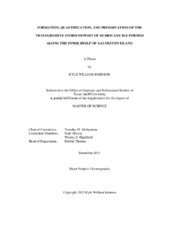| dc.description.abstract | In 2008, Hurricane Ike made landfall at Galveston Island, Texas, and caused significant impacts on the coastal environment. An assessment of the impact of Hurricane Ike on the shoreface and inner shelf sediments that occur offshore of the island was made by using seafloor bathymetric and acoustic backscatter data obtained by sonars together with information about seafloor sediments obtained by cores. Pre-storm data from surveys collected between 2001 and 2007 were compared to post-storm data collected during 2011 (no other hurricanes or tropical storms struck near Galveston during the time period when data were collected). Our results reveal the existence of bars containing between 1,800,000 m^3 – 3,000,000 m^3 of sand, in water depths ranging from 6.5 m and 10 m. The non-hurricane wave-base was estimated to be 5.8 m, placing these bars well below “fairweather” or non-hurricane wavebase.
Previous research on the sand flux to the shore face (4m-8m) estimate that 115,000+-28 m^3 y^-1 of sand is sequestered along Galveston Island. For the sake of this study, I will use the upper limit of the Galveston Island sediment sequestration estimate of 143,000 m^3 y^-1 as an estimate of annual sediment sequestration within the shoreface (0-10 m isobaths).
I hypothesized that the volume of sand within Hurricane Ike formed bars is significantly larger than the estimated average annual sediment sequestration of the shoreface of Galveston Island.
Using the average volume of the Hurricane Ike bars over the 4 year interval from 2007-2011, the average sediment sequestration for the interval below fairweather wave base is 750,000 m^3 y^-1. This means that the volume of sediment contained within the Hurricane Ike bars is between approximately 3 and 5 times the estimated annual shoreface sediment sequestration, confirming the hypothesis. Measurements further reveal that the volume of sediment stored within the Hurricane Ike bars is almost twofold (1.8x) the estimation what would be required to maintain the beach under storm conditions. This volume is also approximately 2-3 times higher than the estimated sediment flux from Sabine Pass to San Luis Pass. It should be noted that this study does not include changes within the upper shoreface, which was also highly erosional, but only considers sand lost from the system by being transported offshore below the depth of fairweather wavebase. | en |


